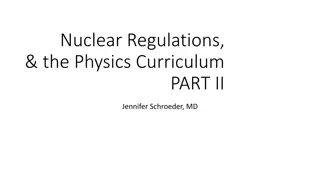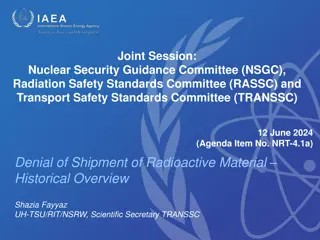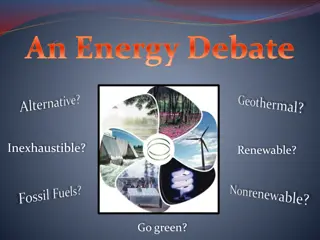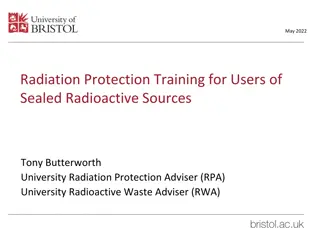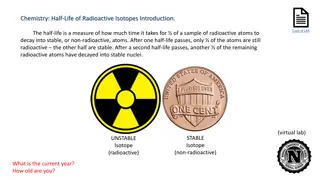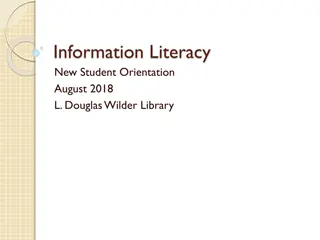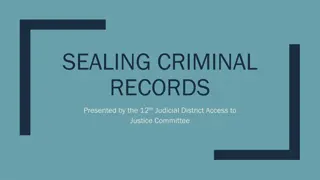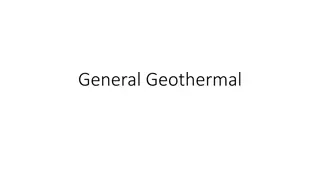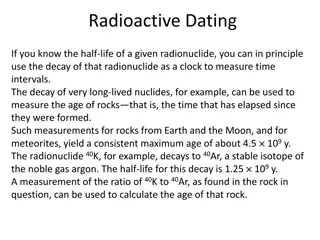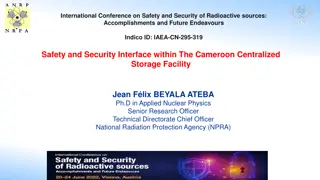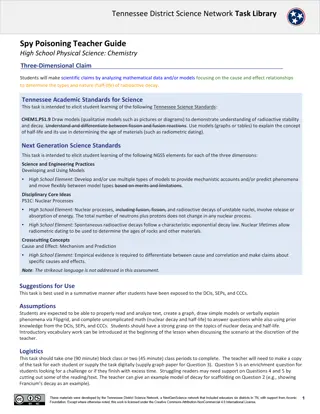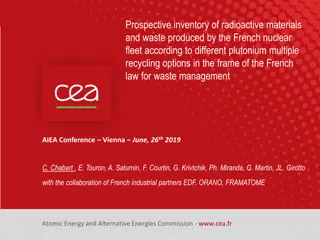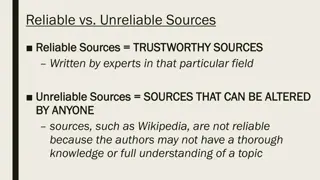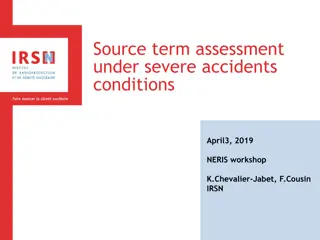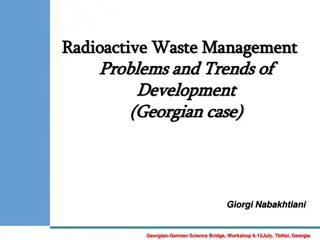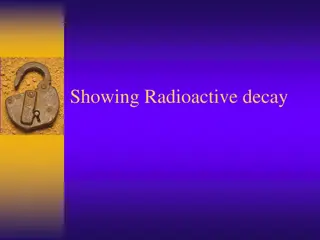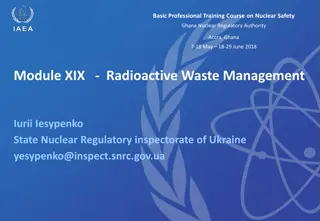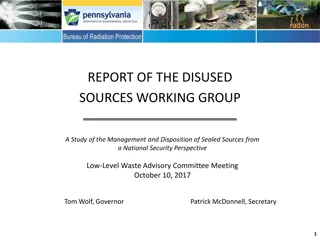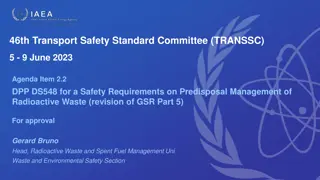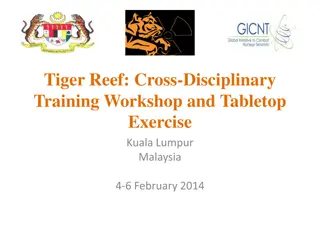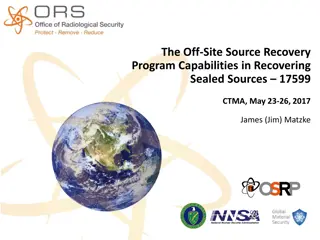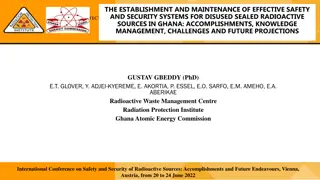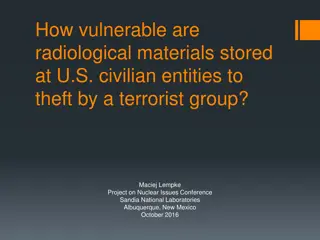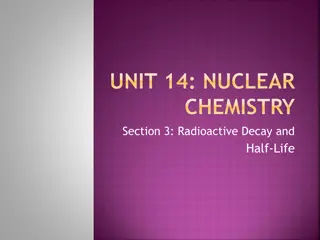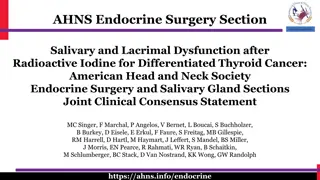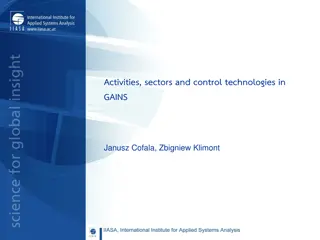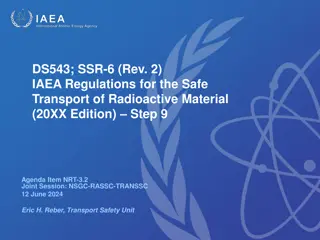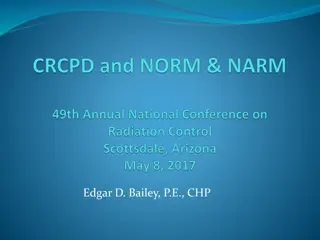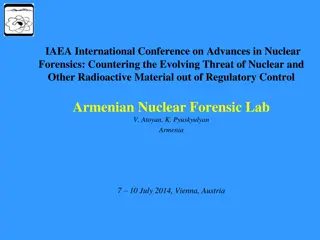Best Practices for Handling Radioactive Spills in Nuclear Medicine Facilities
Understanding the guidelines for dealing with radioactive spills is crucial in nuclear medicine. This comprehensive guide covers major and minor spill scenarios, steps to take in case of a spill, and special considerations for radioactive gas spills. Learn how to ensure safety, prevent contamination
1 views • 34 slides
Understanding Radioactive Decay and Nuclear Radiation
Radioactive decay is the process in which unstable atomic nuclei emit charged particles and energy, transforming into different elements. This process involves the emission of alpha particles, beta particles, and gamma rays. Alpha particles consist of two protons and two neutrons, beta particles are
4 views • 31 slides
Understanding Half-Life in Physics
Half-life is a key concept in physics, particularly in radioactive decay. It is the time taken for the activity of a radioactive source to decrease to half of its original value. This can be determined experimentally through measuring counts per minute and graphing the data. Additionally, half-life
2 views • 11 slides
National Radioactive Waste Management Plan Overview
Briefing the Select Committee on Land Reform, Environment, Mineral Resources, and Energy about the South African Radioactive Waste Management Programme and the legislative background governing radioactive waste management. The presentation outlines the framework, guiding elements, waste management p
4 views • 19 slides
Evolution of Radiopharmacy: A Specialized Field in Pharmacy
The evolution of radiopharmacy as a specialty has progressed rapidly since the 1950s, involving the preparation, dispensing, and clinical investigation of radioactive materials as drugs. Radiopharmacy plays a crucial role in the development and use of radiopharmaceuticals for diagnostic, therapeutic
3 views • 53 slides
Overview of Denial of Shipment of Radioactive Material in NSGC, RASSC, & TRANSSC Joint Session
The Joint Session held by the NSGC, RASSC, and TRANSSC on June 12, 2024, discussed the historical overview and implications of denying shipments of radioactive material. It highlighted the importance of coordination with UN organizations and industry groups in ensuring the safe transport of such mat
1 views • 7 slides
Sources of Drugs and Their Origins
Drugs can be sourced from six major categories: plants, animals, minerals/earth, microbiological sources, semi-synthetic sources, synthetic sources, and recombinant DNA technology. Plant sources, being the oldest, provide various medicinal properties through leaves, flowers, fruits, seeds, roots, ba
0 views • 11 slides
Understanding the Debate on Inexhaustible vs. Nonrenewable Energy Sources
The energy debate revolves around the classification of energy sources into nonrenewable, renewable, and inexhaustible categories. Fossil fuels, such as coal, petroleum, and natural gas, fall under nonrenewable sources due to their finite nature, while wind and tidal energy are examples of inexhaust
0 views • 18 slides
Radiation Protection Training for Users of Sealed Radioactive Sources - May 2022
This document provides radiation protection training tailored for users of sealed radioactive sources, ensuring compliance with legislative requirements and university policies. The training covers topics such as ionising radiation, effects of exposure, monitoring requirements, and more. All trainin
0 views • 81 slides
Exploring Radioactive Decay: A Half-Life Lab Simulation
Explore the concept of radioactive decay through a virtual lab simulation involving strontium-90 (Sr-90) and yttrium-90 (Y-90) isotopes. Witness the decay process over multiple half-lives as unstable atoms transform into stable nuclei. Dive into the intricacies of half-life measurements and the vast
0 views • 10 slides
Understanding Information Literacy: A Comprehensive Guide for Students
Information literacy is crucial for academic success. It involves the ability to recognize the need for information, locate relevant sources, evaluate their credibility, and effectively use the information for research and presentations. Primary and secondary sources play a vital role in gathering i
0 views • 19 slides
Understanding the Process of Sealing Criminal Records
Having a criminal record sealed means making it inaccessible to the public while keeping it available to criminal justice agencies. Eligibility for sealing records requires taking action, and not everyone qualifies. This clinic provides guidance on the sealing process and the types of records that c
0 views • 36 slides
Utilizing DOE Low-Level & Mixed Low-Level Waste Disposal Contracts
EMCBC manages disposal and treatment contracts for Low-Level Waste (LLW) & Mixed Low-Level Waste (MLLW). Eligible users include DOE offices, prime contractors, and subcontractors. Services cover various waste types including radioactive materials, sealed sources, and TSCA-regulated waste. Specific c
0 views • 19 slides
Comprehensive Environmental Chemistry Open Course Overview
This open course offered by the Department of Chemistry covers various aspects of environmental chemistry, including air and water pollution, soil pollution, noise pollution, thermal pollution, and radioactive pollution. Students will learn about the causes and effects of different types of pollutio
3 views • 9 slides
Accelerator Technology R&D Targets and Sources Overview
The SnowMass2021 Accelerator Frontier AF7 focuses on Accelerator Technology R&D, exploring targets and sources such as high brightness electron sources, muon sources, and high intensity ion sources. The community planning meeting discussed various Letter of Interest submissions outlining innovative
0 views • 7 slides
Understanding Nuclear Physics: Inside the Nucleus and its Impact
This content explores nuclear physics, covering topics like what's inside the nucleus, radioactivity, half-life, carbon dating, nuclear energy, fission, fusion, reactors, and weapons. It delves into the structure of the nucleus, radioactive decay processes, nuclear reactions, biological effects of r
0 views • 29 slides
Geothermal Energy: Sources and Applications
Geothermal energy is harnessed from Earth's internal heat sources, such as radioactive decay and residual heat. Different geothermal energy sources include hot water reservoirs, natural steam reservoirs, and geopressured reservoirs. This renewable energy is utilized for space heating, air conditioni
0 views • 22 slides
Understanding Radioactive Dating Methods
The process of radioactive dating involves utilizing the decay of radionuclides to measure time intervals, with applications in determining the age of rocks and artifacts. Techniques such as radiocarbon dating, based on isotopes like 14C, enable scientists to determine the age of organic materials b
0 views • 4 slides
Safety and Security Measures at Cameroon's Centralized Storage Facility
The Centralized Storage Facility in Cameroon, established to manage disused sealed radioactive sources, incorporates safety and security measures in an integrated manner. The facility consists of ISO containers, alarm monitoring stations, and implements security enhancements based on IAEA guidelines
0 views • 15 slides
Investigating Agent Z's Poisoning: A Case of Radioactive Decay
Agent Z, a double spy, was poisoned with Polonium-210, a heavy, radioactive element. This task challenges students to analyze the cause of his death using concepts of nuclear decay and half-life modeling based on provided data and models. The scenario involves understanding the effects of radioactiv
0 views • 14 slides
Prospective Inventory of Radioactive Materials and Waste Management Study in French Nuclear Fleet
The study conducted by the French Atomic Energy Commission in collaboration with industrial partners like EDF, Orano, and Framatome explores different plutonium recycling options in the French nuclear fleet. It assesses scenarios involving open cycle, mono-recycling, and multiple recycling of pluton
0 views • 16 slides
Understanding Reliable and Unreliable Sources for Research
Recognize reliable and unreliable sources for research. Reliable sources, such as books and peer-reviewed journals, are authored by experts in the field. Unreliable sources like Wikipedia and blogs can be altered by anyone. Learn how to evaluate the credibility of online sites based on their URLs an
0 views • 10 slides
Understanding Source Term Assessment in Severe Nuclear Accidents
Delve into the complexities of source term assessment under severe accidents conditions, focusing on core degradation, containment pressure buildup, radioactive species release, safety systems, iodine-related phenomenology, and assessing the radioactive source term's impact on the environment. This
0 views • 21 slides
Understanding Primary and Secondary Sources in Research
Primary sources provide firsthand information from the time period being studied, while secondary sources offer interpretations based on primary sources. Examples of primary sources include autobiographies, speeches, historical documents, published firsthand accounts, and sound recordings. Secondary
0 views • 23 slides
Challenges in Radioactive Waste Management: A Case Study of Georgian-German Science Collaboration
This document delves into the management of radioactive waste, highlighting the problems, trends, and development in the Georgian context. It explores the principles set by the IAEA for waste management, emphasizing the protection of human health, environment, and future generations. The discussion
0 views • 21 slides
Understanding Radioactive Decay and Isotopes in Chemistry
Explore the fascinating world of radioactive decay, isotopes, and nuclear transformations in this educational resource. From reviewing atomic numbers to illustrating alpha and beta decay processes, discover the fundamental principles behind these phenomena with detailed explanations and visuals. Del
0 views • 17 slides
Comprehensive Module on Radioactive Waste Management in Nuclear Safety Training
This module XIX on Radioactive Waste Management explores the generation, classification, treatment, storage, and disposal processes of radioactive waste. It covers the nature and sources of radioactive waste in medical, industrial, and research settings. The module also delves into the regulatory co
0 views • 106 slides
Disused Sources Working Group Report on National Security Perspective
The Disused Sources Working Group (DSWG) report focuses on managing and disposing of sealed sources to reduce national security risks. Formed in 2011, DSWG developed recommendations to enhance the management of disused sealed sources. The report categorizes sealed sources based on potential harm and
0 views • 15 slides
Revision of Safety Requirements for Predisposal Management of Radioactive Waste at 46th TRANSSC
The 46th Transport Safety Standard Committee addresses the revision of GSR Part 5 concerning the predisposal management of radioactive waste. This update aims to harmonize safety requirements with current standards and establish protocols for the safe handling of all types of radioactive waste. The
0 views • 17 slides
Cross-Disciplinary Training Workshop on Radioactive Materials Incident Response
Emphasizing the importance of communication and cooperation between different communities, the Tiger Reef workshop in Kuala Lumpur focused on enhancing capabilities to manage incidents involving radioactive materials. With participants from 21 countries, the workshop aimed to bridge gaps in SOPs, co
0 views • 15 slides
Overview of Off-Site Source Recovery Program Capabilities
The Off-Site Source Recovery Program (OSRP) aids in recovering radioactive sealed sources for national security and public health. OSRP focuses on recovering TRU and non-TRU sources, with over 38,500 sources retrieved globally. Services include source registration, consultancy, and training for vari
0 views • 25 slides
Understanding Dry-Type Transformers: Classification and Maintenance
Dry-type transformers come in ventilated, non-ventilated, and sealed units, each with specific construction features and maintenance requirements. Ventilated transformers allow air circulation, non-ventilated operate in a sealed enclosure, and sealed units are self-cooled. Regular checks are essenti
0 views • 35 slides
Effective Safety and Security Systems for Disused Sealed Radioactive Sources in Ghana
Ghana has benefited from the peaceful use of sealed radioactive sources in various sectors. The establishment of safety measures, security systems, and knowledge management for disused sealed radioactive sources (DSRS) is crucial. Challenges and future projections in this area are discussed, emphasi
0 views • 15 slides
Vulnerability of Radiological Materials to Theft by Terrorist Groups in US Civilian Entities
The vulnerability of radiological materials stored at US civilian entities to theft by terrorist groups, particularly low-activity sources, remains a significant concern. Security measures primarily focus on high-activity sources, leaving lower activity sources neglected and highly susceptible to ex
0 views • 16 slides
Understanding Radioactive Decay and Half-Life in Nuclear Chemistry
Exploring the concept of radioactive decay and half-life in nuclear chemistry, this content covers the types of nuclear radiation, alpha decay of Uranium, and the significance of half-life in determining the decay of radioactive substances such as Carbon-14. An example with Fluorine-18 illustrates t
0 views • 9 slides
Salivary and Lacrimal Dysfunction after Radioactive Iodine Treatment
Radioactive iodine (RAI) is commonly used in treating differentiated thyroid cancer but can lead to salivary and lacrimal dysfunction. This joint clinical consensus statement by the American Head and Neck Society Endocrine Surgery and Salivary Gland Sections highlights the importance of understandin
0 views • 20 slides
Activities, Sectors, and Control Technologies in GAINS Research
The GAINS research by Janusz Cofala and Zbigniew Klimont focuses on aggregation criteria for emission sources, macroeconomic parameters such as population and GDP, aggregation of energy-related sources, transport sources, and process sources. It also covers specific VOC processes/sources like solven
0 views • 13 slides
International Regulatory Framework for Radioactive Material Transport Safety
SSR-6 (Rev.1) establishes safety requirements for transporting radioactive material to protect people and the environment from ionizing radiation. The framework applies globally across land, water, and air transport modes, involving operations and conditions related to radioactive material movement.
0 views • 24 slides
Regulatory Evolution of Radioactive Materials Licensing
The regulatory landscape surrounding Naturally Occurring and Accelerator-Produced Radioactive Materials (NARM) underwent significant changes in the 20th century. Various entities, including AEC/NRC and states, grappled with the regulation of NARM, leading to a lack of consistency. Initiatives such a
0 views • 17 slides
Challenges and Solutions in Protecting Radioactive Sources in Post-USSR Armenia
The collapse of the USSR presented Armenia with challenges in managing radioactive materials due to limited resources and unclear responsibilities. Incidents of illicit trafficking of radioactive sources have been reported, highlighting the need for robust regulatory controls and forensic capabiliti
0 views • 20 slides
